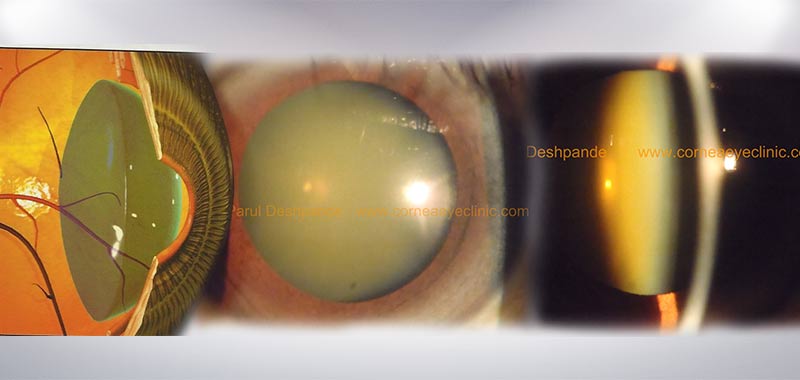

25 Sep Cataract
Cataract is the age related clouding of natural clear lens of the eye. It is slow and progressive in nature.
Are there any risk factors for developing cataract?
Yes, there are. Conditions like uncontrolled diabetes, Injury to the eyes, long extended unsupervised use of steroids in tablet, injection or drops form, previous eye surgery, family history of cataract etc can predispose to development of early cataract.
Children also can develop cataract either by birth or later in conditions with Down’s syndrome or part of other diseases.


How do I know that I have cataract?
- Haziness or cloudy vision
- Increased glare or inability to see in bright or dim lights, difficulty in driving
- Double or multiple images of an object
- Frequent change in glass power
- Second sight of life i.e. ability to see near things without near glasses in a farsighted person
These are some of the problems that your eyes may face when developing cataract.


Is overuse of eyes related to development of cataracts?
No. Cataract is not caused by overuse of your eyes and using your eyes when the cataract starts will not make it get worse.
How do you treat cataract?
Cataract once developed, needs removal by operation. However, one can decide the timing of removal depending upon, the difficulties, they face in their daily routine, due to blur or poor vision. Initial stages of cataract can, at times, be managed with change of glasses, which may be required very frequent,every few months.
Can a cataract come back again?
A cataract ,once removed, can never come back again as all the parts ,except the lens capsule, is removed. In some cases, esp. this capsule may become thick and white after few years of surgery and cause vision problem. This can be cleared by using a YAG laser light in the outpatient clinic and a person can see as clearly as after cataract surgery immediately.
I have had previous laser treatment to my eyes. Does it have any bearing on the outcome?
If laser treatment for short or long sightedness has been performed in your eyes, it is very important that you tell the doctors during your first consultation.
Excimer laser treatment affects the calculations that are used to determine the power of lens implant. Newer equipments provide near accurate Lens powers.This may require spectacles or contact lenses to be worn even after the cataract surgery or may need a further excimer laser surgery or exchange of the lens by a surgery.
Are there any ways or lenses that if implanted can make me glass free?
One can expect to be glass free when implanted with a right intraocular lens. One can correct different errors of the eye like far or nearsightedness, Astigmatism or Presbyopia with the different intraocular lenses available. It is only if you address all the errors, you can expect glass free vision following the operation.
Phacoemulsification and Femtocataract Technology
Phacoemulsification is the technique used nowadays to remove the cataract.Femtosecond lasers can be used as an add on procedure to
Phacoemulsification technique of cataract removal to facilitate a relatively minimally invasive procedure. Microcoaxial Phacoemulsification involves use of below 2.2mm self sealed incision (laser or blade enabled) to help remove the cataract through minimalistic approach.No stitches are used to close the surgical wound as it is self sealing.Literature does not support any added benefits of Femtotechnology over phacoemulsification.
What is Ozill Infinity system of Phacoemulsification?
Ozil Infinity phacoemulsification is an integrated program which combines
- Torsional Ultrasound system, more effective for hard and mature cataracts.
- Micro coaxial small incision system ( MCCS or MICS ).
- Intrepid Fluidics system to maintain a stable & safe eye chamber during the operation.
- Complete disposable (no reuse) system, decreasing the risk of infection and better aspiration of broken cataract pieces with excellent fluidics management.
- Autosert Intraocular lens injector-which allows controlled introduction of the lens inside the eye.
What is Torsional Phacoemulsification?
The Ozil torsional portion is a hardware and software upgrade of the machine that produces rotary oscillations of the needle tip at a fast rate. This movement does not produce repulsion and breaks up cataract by shearing and hence reduces heat developed and quick breakdown of the cataract. In conventional machine, the US power breaks the cataract by moving the needle tip forward and backward at a high speed. This produces repulsion effect pushing the cataract away with each stroke as it moves forward. Thus, the US is interrupted and efficiency is compromised.
What is MCCS or MICS (Micro Coaxial Phacoemulsification)?
A cut taken for introducing the phacoemulsification needle and to introduce the intraocular lens into the eye is very small, about 2.75 mm with conventional technique. With MCCS, it is smaller to 2.2 mm and MICS it is near to 1.8 mm allowing the cut to be a square rather than rectangle, which increases the stability of wound significantly. This ultra-small incision allows a very safe wound minimizing the chances of infection and also a step towards the no glass outcome following a cataract surgery.
Tips while undergoing a cataract surgery
- Understand the need of cataract surgery in your eye.
- Understand the possibility of Glass free vision,if needed,though at higher cost than routine lens implantation surgery in some of the eyes esp.
- All Intraocular lenses are eye friendly , but one needs to customize the type of IOL for his or her eye . Some of the premium range customized IOLs include Aspheric IOls (which provide better quality with quantity of vision), Toric IOLs (Cylinder correcting Lenses), Multifocal or Accommodating IOLs ( For unaided near vision with unaided far vision) or Multifocal toric IOLs.
- Confirm Your Insurance validity as well as the amount sanctioned by the insurance firms to avoid last minute confusion about the package selection for cataract surgery.One may have to co-pay a certain amount for premium IOLs as all may not be covered by your insurance company.
- Preoperative Blood Tests like blood sugar,Urine test and Triple antigen tests are mandatory for the safety of the surgery. A test conducted within 3 months (except in diabetics) of the cataract surgery is usually safe.
- Understand the medications before and after the surgery well , in advance.
- One can resume daily activities like outdoor walk ,reading a newspaper,watching TV or cooking in 48 hours after surgery, after confirmation from your doctor.
- Dietary restrictions after a cataract surgery are nil , except in patient with Diabetes or High Blood pressure.
- Glasses can be prescribed one week after the operation but it is best to check them at 2-3 weeks to avoid any long term fluctuation in glass power, if needed in some eyes.
- Some of the vision artifacts like a moving dot or cobweb in the sight or irritation or increased awareness of something in the eyes is, most of the times,not related to Lens position or implantation.They are due to other factors,which one can clarify with their doctor.


20 Comments